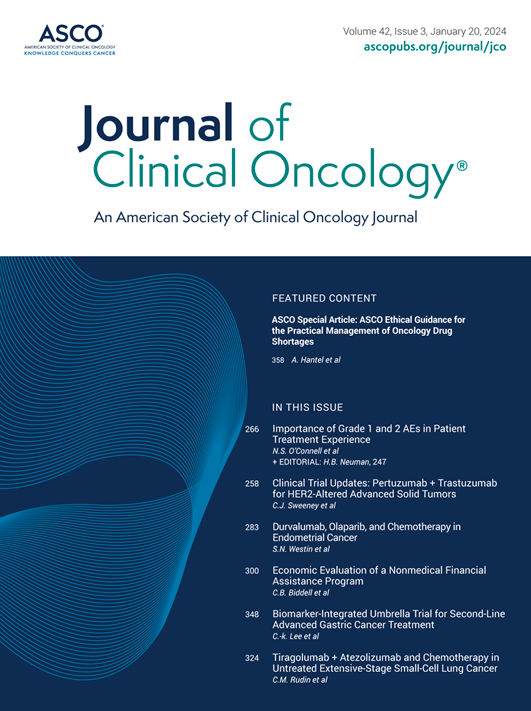131 - metaiodobenzylguanidine联合地努妥昔单抗±伏立诺他治疗复发或难治性神经母细胞瘤的I期研究:神经母细胞瘤治疗的新途径
IF 41.9
1区 医学
Q1 ONCOLOGY
引用次数: 0
摘要
目的:我们进行了一项I期试验,以确定复发/难治性神经母细胞瘤(rNBL)患者中131i -甲氧十二苄基胍(MIBG)联合抗gd2抗体迪努妥昔单抗(或不联合组蛋白去乙酰化酶抑制剂vorinostat)的安全性、耐受性和初步抗肿瘤活性。方法在A部分中,MIBG-avid rNBL患者在第1天静脉注射MIBG,剂量分别为12、15或18 mCi/kg(按滚动6设计),在第8-11天和第29-32天静脉注射迪努妥昔单抗(17.5 mg/m2每日1次),在第8-17天和第29-38天皮下注射粒细胞-巨噬细胞集落刺激因子(250 mcg/m2每日1次)。第15天输注自体干细胞。在B部分,沃立诺他180mg /m2,每日一次,在0-13天口服,与A部分推荐的II期剂量(RP2D)联合使用。患者可接受两个疗程。结果纳入45例符合条件的患者,其中31例可评价。中位年龄为7.5岁(2.9-24.1岁)。对于A部分(n = 19),在所有剂量水平和疗程中均未发生剂量限制性毒性(dlt),确定MIBG的RP2D为18 mCi/kg。在B部分(n = 12)中,1例DLT(3级低钾血症)发生在第1个疗程中,11例接受第2个疗程的患者中有3例发生DLT: 3级ALT升高,4级缺氧和5级肺炎,3级疲劳。最佳总体反应率(BORR;A部分的完全缓解[CR] +部分缓解[PR]为42%,CR/PR/轻微缓解(MR)率为46%,进展性疾病(PD)率为19%。B组BORR为42%,CR/PR/MR率为75%,PD率为0%。结论mibg联合地努妥昔单抗耐受性好,抗肿瘤活性增强。伏立诺他加入到这一组合中可能会增强这种重度预处理患者群体的反应。本文章由计算机程序翻译,如有差异,请以英文原文为准。
Phase I Study of 131I-Metaiodobenzylguanidine With Dinutuximab ± Vorinostat for Patients With Relapsed or Refractory Neuroblastoma: A New Approaches to Neuroblastoma Therapy Trial.
PURPOSE
We conducted a phase I trial to determine the safety, tolerability, and preliminary antitumor activity of 131I-metaiodobenzylguanidine (MIBG) combined with the anti-GD2 antibody dinutuximab with or without the histone deacetylase inhibitor vorinostat in patients with relapsed/refractory neuroblastoma (rNBL).
METHODS
In part A, patients with MIBG-avid rNBL received MIBG intravenously (IV) on day 1 at 12, 15, or 18 mCi/kg per the rolling six design and dinutuximab (17.5 mg/m2 once daily) IV on days 8-11 and 29-32 and granulocyte-macrophage colony-stimulating factor (250 mcg/m2 once daily) subcutaneously on days 8-17 and 29-38. Autologous stem cells were infused on day 15. In part B, vorinostat at 180 mg/m2 once daily was given orally on days 0-13 in combination with the part A recommended phase II dose (RP2D). Patients could receive two courses.
RESULTS
Forty-five eligible patients enrolled, of whom 31 were evaluable. The median age was 7.5 (range, 2.9-24.1) years. For part A (n = 19), no dose-limiting toxicities (DLTs) occurred across all dose levels and courses, establishing the RP2D of MIBG to be 18 mCi/kg. In part B (n = 12), 1 DLT (grade 3 hypokalemia) occurred during course 1, and 3 of 11 patients who received a second course experienced DLT: grade 3 ALT increase, grade 4 hypoxia and grade 5 pneumonitis, and grade 3 fatigue. The best overall response rate (BORR; complete response [CR] + partial response [PR]) on part A was 42% with a CR/PR/minor response (MR) rate of 46%, and 19% progressive disease (PD) rate. For part B, the BORR was 42% with a CR/PR/MR rate of 75% and 0% PD rate.
CONCLUSION
MIBG combined with dinutuximab was well tolerated with encouraging antitumor activity. Vorinostat added to this combination may augment responses in this heavily pretreated patient population.
求助全文
通过发布文献求助,成功后即可免费获取论文全文。
去求助
来源期刊

Journal of Clinical Oncology
医学-肿瘤学
CiteScore
41.20
自引率
2.20%
发文量
8215
审稿时长
2 months
期刊介绍:
The Journal of Clinical Oncology serves its readers as the single most credible, authoritative resource for disseminating significant clinical oncology research. In print and in electronic format, JCO strives to publish the highest quality articles dedicated to clinical research. Original Reports remain the focus of JCO, but this scientific communication is enhanced by appropriately selected Editorials, Commentaries, Reviews, and other work that relate to the care of patients with cancer.
 求助内容:
求助内容: 应助结果提醒方式:
应助结果提醒方式:


